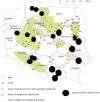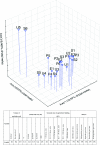The use of pesticides in Polish agriculture after integrated pest management (IPM) implementation
- PMID: 33491144
- PMCID: PMC8159817
- DOI: 10.1007/s11356-020-12283-w
The use of pesticides in Polish agriculture after integrated pest management (IPM) implementation
Erratum in
-
Correction to: The use of pesticides in Polish agriculture after integrated pest management (IPM) implementation.Environ Sci Pollut Res Int. 2021 Jun;28(23):30422. doi: 10.1007/s11356-021-12879-w. Environ Sci Pollut Res Int. 2021. PMID: 33625714 Free PMC article. No abstract available.
Abstract
The aim of the conducted study was to characterize the attitudes and practices of Polish farmers in the area of performing chemical plant protection treatments. A particular attention was paid to identifying the relationship between the direction of changes in the volume of chemical plant protection product consumption and selected attributes of farms. The main time range of the analyses covered the period of 2013-2017. Statistical data and results of representative surveys carried out on a sample of 1101 farms in Poland were used in the research process. Due to the large number of variants of the analysed variables, a multiple correspondence analysis was used, which made it possible to determine the correlation between the examined features (direction of changes in pesticide use relative to the farm area, economic size of the farm and location of the farm). Statistical analysis showed the existence of strong relationships between the physical (1) and economic (2) size of farms and the direction of changes in pesticide consumption ((1) φ2 = 0.0907; (2) φ2 = 0.1141)). According to empirical studies, the reduction of pesticide consumption took place mainly on the smallest farms. The implementation of the integrated plant protection directive has not resulted in significant changes in the form of reduced pesticide use in large-scale field crops. This raises the need to modify the strategy and model of crop protection in large-scale field crops in Poland.
Keywords: Chemical plant protection; Integrated pest management (IPM); Multiple correspondence analysis (MPA).
Figures






Similar articles
-
Do Bolivian small holder farmers improve and retain knowledge to reduce occupational pesticide poisonings after training on Integrated Pest Management?Environ Health. 2014 Oct 1;13:75. doi: 10.1186/1476-069X-13-75. Environ Health. 2014. PMID: 25273338 Free PMC article.
-
Plant protection in Poland on the eve of obligatory integrated pest management implementation.Pest Manag Sci. 2013 Sep;69(9):991-5. doi: 10.1002/ps.3578. Epub 2013 Jul 9. Pest Manag Sci. 2013. PMID: 23696241
-
Pesticide consumption and productivity and the potential of IPM in Bangladesh.Sci Total Environ. 2013 Feb 15;445-446:48-56. doi: 10.1016/j.scitotenv.2012.12.032. Epub 2013 Jan 9. Sci Total Environ. 2013. PMID: 23314122
-
Toward integrated pest management in bivalve aquaculture.Pest Manag Sci. 2022 Nov;78(11):4427-4437. doi: 10.1002/ps.7057. Epub 2022 Jul 21. Pest Manag Sci. 2022. PMID: 35759345 Review.
-
Pest management strategies in traditional agriculture: an African perspective.Annu Rev Entomol. 2000;45:631-59. doi: 10.1146/annurev.ento.45.1.631. Annu Rev Entomol. 2000. PMID: 10761592 Review.
Cited by
-
Multifunctional Adjuvants Affect Sulfonylureas with Synthetic Auxin Mixture in Weed and Maize Grain Yield.Plants (Basel). 2024 May 27;13(11):1480. doi: 10.3390/plants13111480. Plants (Basel). 2024. PMID: 38891289 Free PMC article.
-
What drives low-carbon agriculture? The experience of farms from the Wielkopolska region in Poland.Environ Sci Pollut Res Int. 2022 Mar;29(13):18641-18652. doi: 10.1007/s11356-021-17022-3. Epub 2021 Oct 25. Environ Sci Pollut Res Int. 2022. PMID: 34694556 Free PMC article.
-
Transcriptome Dynamics Underlying Planticine®-Induced Defense Responses of Tomato (Solanum lycopersicum L.) to Biotic Stresses.Int J Mol Sci. 2023 Mar 30;24(7):6494. doi: 10.3390/ijms24076494. Int J Mol Sci. 2023. PMID: 37047467 Free PMC article.
-
Multiple Organic Contaminants Determination Including Multiclass of Pesticides, Polychlorinated Biphenyls, and Brominated Flame Retardants in Portuguese Kiwano Fruits by Gas Chromatography.Foods. 2023 Feb 26;12(5):993. doi: 10.3390/foods12050993. Foods. 2023. PMID: 36900510 Free PMC article.
-
Evaluation of Pesticide Residues Occurrence in Random Samples of Organic Fruits and Vegetables Marketed in Poland.Foods. 2022 Jul 1;11(13):1963. doi: 10.3390/foods11131963. Foods. 2022. PMID: 35804777 Free PMC article.
References
-
- Azam SR, Ma H, Xu B, Devi S, Siddique MAB, Stanley SL, Bhandari B, Zhu J. Efficacy of ultrasound treatment in the and removal of pesticide residues from fresh vegetables: a review. Trends Food Sci Technol. 2020;97:417–432. doi: 10.1016/j.tifs.2020.01.028. - DOI
-
- Bart S, Amossé J, Lowe CN, Mougin C, Péry AR, Pelosi C. Aporrectodea caliginosa, a relevant earthworm species for a posteriori pesticide risk assessment: current knowledge and recommendations for culture and experimental design. Environ Sci Pollut Res. 2018;25(34):33867–33881. doi: 10.1007/s11356-018-2579-9. - DOI - PMC - PubMed
MeSH terms
Substances
LinkOut - more resources
Full Text Sources
Other Literature Sources
Medical

